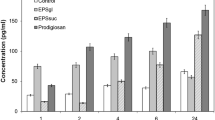Summary
The effect of tumor cells and immunostimulants on the release of cytostatic factors (CF) from Lactobacillus casei YIT 9018 (LC)-, Corynebacterium parvum (CP)- or peptone-elicited peritoneal macrophages (PM) was investigated in vitro and in vivo. Significant release of CF into the culture medium from PM elicited with LC was induced by seven of eight mitomycin C-pretreated tumor cell lines and not by normal spleen cells, while no CF was released extracellularly from peptone-elicited PM given the same stimulus. CF were released from LC-elicited PM (LCEPM) after stimulation with LC, bacille Calmette-Guérin, streptococcal preparation OK-432, fucoidan or lipopolysaccharide, and LC but not CP induced CF production in the peritoneal cavities of LC- or CP-primed mice. The release of CF from LCEPM after stimulation with mitomycin C-pretreated 3T12-3 cells was inhibited by D-mannose and not by L-fucose. L-Rhamnose and mannose 6-phosphate, but not D-mannose or L-fucose, caused the release of CF from the PM.
It was suggested that the release of CF from activated PM is caused by stimulation by some tumor cells, sugars, or bacterial immunostimulants, D-Mannose and L-rhamnose on the surface of tumor cells or bacteria, respectively, may play an important role in the release of CF from activated macrophages.
Similar content being viewed by others
References
Adams DO, Marino PA (1981) Evidence for a multistep mechanism of cytolysis by BCG-activated macrophages: The interrelationship between the capacity for cytolysis, target binding, and secretion of cytolytic factor. J Immunol 126:981
Affarwal BD, Eessalu TE, Hass PE (1985) Characterization of receptors for human tumour necrosis factors and their regulation by γ-interferon. Nature 318:665
Currie GA (1978) Activated macrophages kill tumor cells by releasing arginase. Nature 273:758
Drysdale B, Zacharchuk CM, Shin HS (1983) Mechanism of macrophage-mediated cytotoxicity: Production of a soluble cytotoxic factor. J Immunol 131:2362
Ferluga J, Sharlemmer HV, Baptista LC, Allison AC (1978) Production of the complement cleavage product. C3a, by activated macrophages and its tumorolytic effects. Clin Exp Immunol 31:512
Hakomori S, Nudelman E, Levery SB, Kannagi R (1984) Novel fucolipids accumulating in human adenocarcinoma I. Glycolipids with di- or trifucosylated type 2 chain. J Biol Chem 259:4672
Haranaka K, Satomi N, Sakurai A (1984) Antitumor activity of murine tumor necrosis factor (TNF) against transplanted murine tumors and heterotransplanted human tumors in nude mice. Int J Cancer 34:263
Hashimoto S, Nomoto K, Matsuzaki T, Yokokura T, Mutai M (1984) Oxygen radical production by peritoneal macrophages and Kupffer cells elicited with Lactobacillus casei. Infect Immun 44:61
Hashimoto S, Seyama Y, Yokokura T, Mutai M (1985) Cytotoxic factor production by Kupffer cells elicited with Lactobacillus casei and Corynebacterium parvum. Cancer Immunol Immunother 20:117
Hoflack B, Kornfeld S (1985) Lysosomal enzyme binding to mouse P388D1 macrophage membrane lacking the 215-kDa mannose 6-phosphate receptor: Evidence for the existence of second mannose 6-phosphate receptor. Proc Natl Acad Sci USA 82:4428
Johnson WJ, Pizzo SV, Adams DO (1982) Receptors for maleilated proteins regulate secretion of neutral proteases by murine macrophages. Science 218:574
Leu RW, Herriot MJ (1984) Microassay for photometric quantitation of macrophage mediated tumor cytotoxicity using an automated densitometer. J Immunol Methods 67:63
Mannel DN, Moore RN, Mergenhagen SE (1980) Macrophages as a source of tumoricidal (tumor-necrotizing) factor. Infect Immun 30:523
Mercurio AM (1986) Disruption of oligosaccharide processing in murine tumor cells inhibits their susceptibility to lysis by activated mouse macrophages. Proc Natl Acad Sci USA 83:2609
Mørland B (1985) Cytotoxic factor(s) released from stimulated mouse peritoneal macrophages. Acta Pathol Microbiol Immunol Scand Sect C, 93:131
Nagaoka M, Kamisango K, Fujii H, Uchikawa K, Sekikawa I, Azuma I (1985) Structure of acidic polysaccharide from cell wall of Propionibacterium acnes strain C7. J Biochem 97:1669
Nathan CF (1982) Secretion of oxygen intermediators: Role in effector function of activated macrophages. Fed Proc 41:2206
Philippeaux M-M, Mauel J (1984) Extracellular cytolysis by activated macrophages: Studies with macrophage on permeable membranes. Immunobiology 167:301
Ruff MR, Gifford GE (1981) Rabbit tumor necrosis factor: Mechanism of action. Infect Immun 31:380
Shepherd VL, Campbell EJ, Senior RM, Stahl PD (1982) Characterization of the mannose/fucose receptor on human mononuclear phagocytes. J Reticuloendothel Soc 32:423
Stone S, Fidler IJ (1980) Tumor cytotoxicity of rat alveolar macrophages activated in vitro by endotoxin. J Reticuloendothel Soc 27:269
Takeda Y, Shimada S, Sugimoto M, Woo HJ, Higuchi M, Osawa T (1985) Purification and characterization of a cytotoxic factor produced by a mouse macrophage hybridoma. Cell Immunol 96:277
Takeda Y, Woo HJ, Osawa T (1985) Mouse macrophage hybridomas secreting a cytotoxic factor interleukin. 1. Cell Immunol 90:493
Williamson BD, Carswell EA, Ruinb BY, Prendergast JS, Old LT (1983) Human tumor necrosis factor produced by human B-cell lines: Synergistic cytotoxic interaction with human interferon. Proc Natl Acad Sci USA 80:5397
Yamamoto A, Usami H, Nagamuta M, Sugawara Y, Hamada S, Yamamoto T, Kato K, Kokeguchi S (1985) The use of lipoteichoic acid (LTA) from Streptococuus pyogenes to induce a serum factor causing tumour necrosis. Br J Cancer 51:739
Yokokura T (1971) Phage receptor material in Lactobacillus casei cell wall: 1 Effect of L-rhamnose on phage absorption to the cell wall. Jpn J Microbiol 15:457
Yoshida O, Abe S, Masuko Y (1981) Typing of immunomodulators in terms of their effects on the electrophoretic pattern of serum proteins and antitumor combination therapy based on this typing. Gann 72:471
Author information
Authors and Affiliations
Rights and permissions
About this article
Cite this article
Hashimoto, S., Nomoto, K., Nagaoka, M. et al. In vitro and in vivo release of cytostatic factors from Lactobacillus casei-elicited peritoneal macrophages after stimulation with tumor cells and immunostimulants. Cancer Immunol Immunother 24, 1–7 (1987). https://doi.org/10.1007/BF00199825
Received:
Accepted:
Issue Date:
DOI: https://doi.org/10.1007/BF00199825



